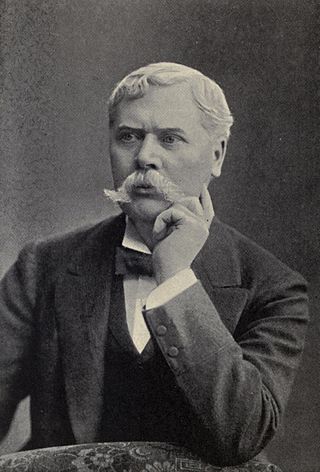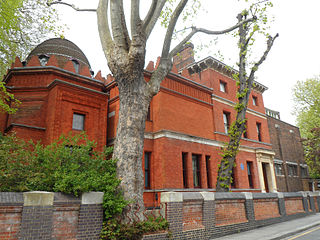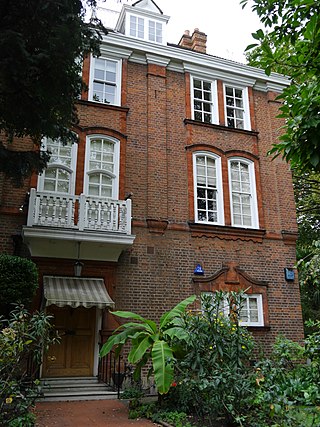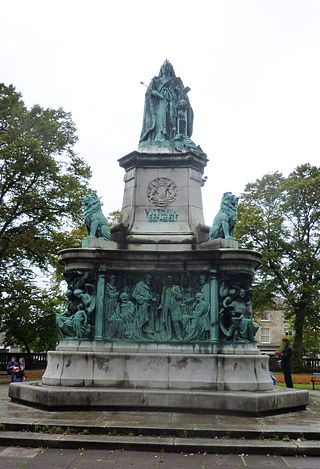
Sir William Hamo Thornycroft was an English sculptor, responsible for some of London's best-known statues, including the statue of Oliver Cromwell outside the Palace of Westminster. He was a keen student of classical sculpture and was one of the youngest artists to be elected to the Royal Academy, in 1882, the same year the bronze cast of Teucer was purchased for the British nation under the auspices of the Chantrey Bequest.

Holland Park is an area of Kensington, on the western edge of Central London, that contains a street and public park of the same name. It has no official boundaries but is roughly bounded by Kensington High Street to the south, Holland Road to the west, Holland Park Avenue to the north, and Kensington Church Street to the east. Adjacent districts are Notting Hill to the north, Earl's Court to the south, and Shepherd's Bush to the northwest.

George Frederic Watts was a British painter and sculptor associated with the Symbolist movement. He said "I paint ideas, not things." Watts became famous in his lifetime for his allegorical works, such as Hope and Love and Life. These paintings were intended to form part of an epic symbolic cycle called the "House of Life", in which the emotions and aspirations of life would all be represented in a universal symbolic language.

Valentine Cameron "Val" Prinsep was a British painter of the Pre-Raphaelite school.

Marcus Stone was an English painter. Stone was born in London, and was educated at the Royal Academy.

The Leighton House Museum is an art museum and historic house in the Holland Park area of the Royal Borough of Kensington and Chelsea in west London.

Sir Samuel Luke Fildes was a British painter and illustrator born in Liverpool and trained at the South Kensington and Royal Academy Schools. He was the grandson of the political activist Mary Fildes.

The Tower House, 29 Melbury Road, is a late-Victorian townhouse in the Holland Park district of Kensington and Chelsea, London, built by the architect and designer William Burges as his home. Designed between 1875 and 1881, in the French Gothic Revival style, it was described by the architectural historian J. Mordaunt Crook as "the most complete example of a medieval secular interior produced by the Gothic Revival, and the last". The house is built of red brick, with Bath stone dressings and green roof slates from Cumbria, and has a distinctive cylindrical tower and conical roof. The ground floor contains a drawing room, a dining room and a library, while the first floor has two bedrooms and an armoury. Its exterior and the interior echo elements of Burges's earlier work, particularly Park House in Cardiff and Castell Coch. It was designated a Grade I listed building in 1949.

Little Holland House was the dower house of Holland House in the parish of Kensington, Middlesex, England. It was situated at the end of Nightingale Lane, now the back entrance to Holland Park and was demolished when Melbury Road was made. Number 14 Melbury Road marks its approximate location.

Woodland House is a large detached house at 31 Melbury Road in the Holland Park district of Kensington and Chelsea, West London, England. Built from 1875 to 1877 in the Queen Anne style by the architect Richard Norman Shaw, it is a Grade II* listed building. Commissioned by the painter Luke Fildes, Woodland House is next to William Burges's Grade I listed Tower House.

Gaetano Giuseppe Faostino Meo was an Italian-British artist's model, landscape painter, and a noted craftsman in mosaic and stained glass. His unpublished autobiography is a useful source for art historians of the Aesthetic Movement and Edwardian Era.

8 Melbury Road is a large detached house at the Holland Park district of Kensington and Chelsea, W14 in England. Built in the Queen Anne style by the architect Richard Norman Shaw, it is a Grade II* listed building.

Holland House, originally known as Cope Castle, was an early Jacobean country house in Kensington, London, situated in a country estate that is now Holland Park. It was built in 1605 by the diplomat Sir Walter Cope. The building later passed by marriage to Henry Rich, 1st Baron Kensington, 1st Earl of Holland, and by descent through the Rich family, then became the property of the Fox family, during which time it became a noted gathering-place for Whigs in the 19th century. The house was largely destroyed by German firebombing during the Blitz in 1940 and today only the east wing and some ruins of the ground floor and south facade remain, along with various outbuildings and formal gardens. In 1949 the ruin was designated a grade I listed building and it is now owned by the Royal Borough of Kensington and Chelsea.

The Queen Victoria Memorial in Lancaster, Lancashire, England, is a Grade II* listed building. It stands in the centre of Dalton Square, Lancaster facing Lancaster Town Hall. It was erected in 1906, being commissioned and paid for by James Williamson, 1st Baron Ashton.
Emilie Isabel Barrington, was a British biographer, artist, and novelist. She became associated with the Holland Park Circle, was instrumental in establishing Leighton House Museum, and co-founded the Kyrle Society.

Colin Hunter was a Scottish artist of the Victorian era. Most of his works are seascapes.

Melbury Road is a residential road in the Holland Park area of the Royal Borough of Kensington and Chelsea, London, England. It is known for houses owned by the Victorian Holland Park Circle, an informal group of 19th-century artists, including William Burges, Luke Fildes, Frederic Leighton, Valentine Prinsep, Hamo Thornycroft, and George Frederick Watts.

Holland Park Road is a residential road in the Holland Park district of the Royal Borough of Kensington and Chelsea, London, England. It is especially known for Leighton House, owned by the artist Lord Frederic Leighton, President of the Royal Academy and leading light of the Victorian Holland Park Circle, an informal group of 19th-century artists, including William Burges, Luke Fildes, Frederic Leighton, Valentine Prinsep, Hamo Thornycroft, and George Frederick Watts, who lived in the area.

















